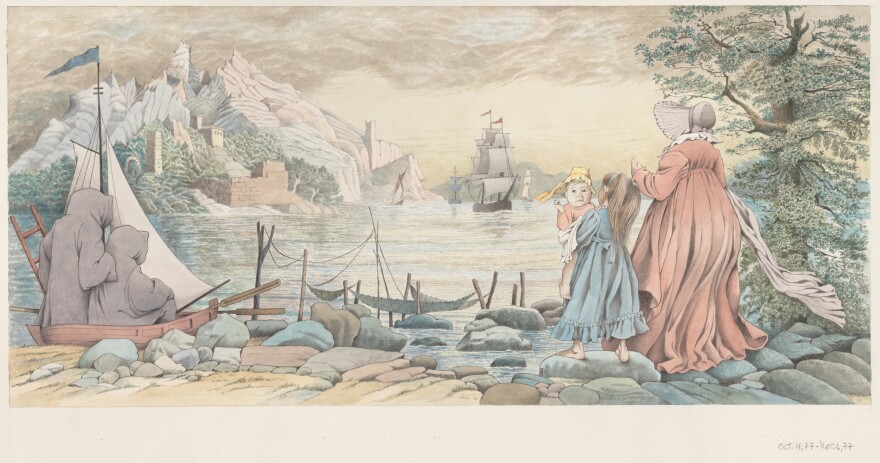When Lynn Caponerra was 12, she visited Maurice Sendak’s house down the street in Ridgefield Connecticut where her brother was the caretaker. In a way, she never left. She became Sendak’s assistant, and he considered her his daughter. Every day when she went into his studio, music was playing, especially Mozart. Sendak was warming up with his fantasy sketches. He would play one piece of classical music from a record, and he had to completely draw a fantasy story in the style of an artist. He drew many little scenes all on one piece of paper before the music finished.
“There’s fantasy sketches that look like Goya,” Caponerra said, “and there’s fantasy sketches that look like Rembrandt, there’s Chagall. You could look at these and see this is who was listening to, this is who was looking at. It looks like it’s so simple, and carefree, the way his line is. But it’s amazing how much is in those lines.”
Maurice Sendak often said art was his salvation, keeping his severe depression at bay. He collected works from the artists who inspired him, such as the prints of Goya, and the watercolors of William Blake. Caponerra said, “It was like having friends come to dinner when he would get artwork. A Blake would often spend like a month on the floor propped up in our living room where we ate and watched television. So we would see it all the time, it would sit on the couch or on the floor. It would be there until he decided where it would have its final place in the house.”

Jonathan Weinberg curated this show. He says this was part of Sendak’s process. Jonathan Weinberg’s mother died when he was fifteen, and Sendak and his life partner became like parents to him. That’s how he became an artist and art historian. Weinberg compares Sendak’s deep immersion into the works of artists to a famous line from Where the Wild Things Are when the Wild Things say to Max, “We’ll eat you up, we love you so!” He said you “pursue yourself through the things that you love. You know you give yourself to another artist, and somehow, they give back the thing that you need.”
Sendak called it stealing. And he took from everything. Sendak stole from early 19th century German artists when he created the classic book, Outside Over There which takes place in Mozart’s time. In the story, Ida must journey into the unknown to rescue her baby sister from the goblins who have kidnapped her. Weinberg says the pictures bring out “these epic scenes of conflict and narrative color and that’s going on in these great huge almost panoramic images that are in some ways cinematic.”
During this time, Sendak had become obsessed with the art of neoclassical painter Otto Phillip Runge. Weinberg says that Runge “was known for paintings of strange, weird giant-like children and big sunflowers.”

Sendak’s most ambitious art and stories lead us into unsettling dreamscapes that children must find their way through. Weinberg points out that Sendak’s work “was all about fantasy, right? But he really was a realist. He’s always talking about the truth in his work, always saying that the important thing is to tell the truth to children. And so it’s not enough to dream something up, you also have to make it concrete. And I think an artist like Runge has that strange combination of things being very real looking and at the same time unreal or uncanny.”
Sendak used a light box to transform works from the history of art into his own creations. He would trace portions of the paintings, etchings, or print. He also traced period photographs he collected and photos of people he posed to match the precise images he wanted in the book. He would then manipulate these tracings, remaking them, layering them like Photoshop, and making them his own. Only then, would he take out his brushes and paint. Weinberg says, “That’s exactly the way he constructed his pictures. And I would really say “construct them.” Different I think from a lot of the artists that he admired. But it allows him to be himself.”
Now in this show we can see exactly how Sendak repeatedly reinvented his art by constructing from the artists of the past. “Wild Things are Happening” at the Columbus Museum of Art runs until March before an international tour.
Support for Culture Couch comes from WYSO Leaders Frank Scenna and Heather Bailey, who are proud to support storytelling that sparks curiosity, highlights creativity and builds community and Ohio Arts Council.
Culture Couch is created at the Eichelberger Center for Community Voices at WYSO.


